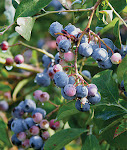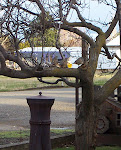 |
| Bishop Weed, also known as Goutweed ~ Aegopodium podagraria |
Aegopodium podagraria, commonly called ground elder, herb gerard, bishop's weed, goutweed, and snow-in-the-mountain, is a perennial plant in the carrot family (Apiaceae) that grows in shady places. The name "ground elder" comes from the superficial similarity of its leaves and flowers to those of elder (Sambucus), which is unrelated. It is the type species of the genus Aegopodium. This species is native to Eurasia, and has been introduced around the world as an ornamental plant, where it occasionally poses an ecological threat as an invasive exotic plant.
I do use the flowers (which are quite fragrant) and leafy stems in arrangements but you have to presoak them before using as the wilt rather quickly. As for it being edible, I wouldn't try it. It's medicinal properties need more research.
 |
Bishop Weed-Snow on the Mountain ~ Aegopodium podagraria 'Variegatum' |












